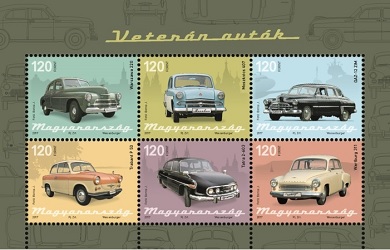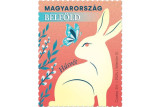
Veterán autók kisív
Az egykor népszerű, ma már inkább ritkaság számba menő veterán autókról bocsát ki bélyeget a Magyar Posta. A bélyegkisív Weisenburger István grafikusművész tervei alapján a Pénzjegynyomda Zrt.-ben 60 000 példányban készült. Az újdonság szeptember 1-től kapható.

Veterán autóvá válni nem csak kort, hanem minőséget is jelent, hiszen az nem elég, hogy a típus harminc évesnél öregebb legyen, az is feltétel, hogy a jármű megjelenése és szinte minden alkatrésze harmóniában legyen a gyárival. Néhány eleme lehet kopott vagy sérült, attól még kaphat némi adózási és biztosítási előnnyel járó OT, vagyis Old Timer rendszámot.
A kisív első bélyegén a lengyel Warszawa 220-as látható. A púpos karosszériás autót korábban Pobjeda M20-asként gyártották Gorkijban (Szovjetunió). A Fabryka Samachodow Osobowych üzemében 1951 és 1973 között összesen 255 ezer Warsawa készült, sok szolgált taxiként, rendőrkocsiként és állami autóként.
A következő bélyegen a Moszkvics 407-es látható: a kétszínűre fényezett, króm hűtőmaszkos és lökhárítós modell első változata 1958-ban gördült le a Moszkvai Autógyár szalagjáról, ahol 1930-tól gyártottak személykocsikat GAZ A jelzéssel, majd 1940-től KIM néven. Az első Moszkvics márkájú és 400-as jelzésű modell 1947-ben készült, döntően a háborús jóvátétel fejében a Szovjetunióba telepített Opel-gépsorokkal. 1963 októberéig 360 ezer Moszkvics 407-es készült, minden harmadik exportra került.
A népautónak szánt Moszkvicsnál jóval kisebb darabszámban gyártották a protokoll célokra tervezett GAZ 12-ZIM autót, mely tulajdonképpen egy hosszabbított szerkezetű hétszemélyes Pobjeda volt. Az 1949-ben bemutatott amerikai stílusú és kissé barokkos formájú modellből 1959-ig 21,5 ezret gyártottak Gorkijban.
Kelet-Európa népautójának szánták a negyedik címleten látható Trabantot. A II. világháború utáni acélínséges időkben a Trabant karosszériaelemei műanyagból (duroplast) készültek. A P50-ös Trabant első kerekeit léghűtéses, kétütemű, kéthengeres motor hajtotta. Az első Trabant 1957-ben készült, a nagyközönség a következő évben láthatta a Lipcsei Vásáron. Zwickauban 1962-ig 131,4 ezer P 50-es készült. Az utolsó – már négyütemű motorral hajtott – Trabant, a 3 086 862-ik 1991. április 30-án gördült le a szerelőszalagról.
Az egykori csehszlovák járműipar reprezentánsa a farmotoros Tatra 2-603-as, melyet 1955-ben három fényszóróval mutattak be, majd 1963-ban megjelent a látványos krómkeretbe foglalt „négyszemű” változat, ezt 2,5 literes, 105 lóerős teljesítményű benzines erőforrás hajtotta. A 603-asokból 1977-ig húszezernél több készült.
A Trabantnál tágasabb és kényelmesebb Wartburgot szintén kétütemű, de nagyobb – három hengeres, 900 köbcentiméteres – és folyadékhűtéses benzinmotor hajtotta. A négyajtós kocsi tetszetős és ma is szépnek tekinthető karosszériáját a korábban BMW-lakatosként dolgozó Hans Fleischer tervezte. A 311-es Wartburg Limousine változatát 1955 tavaszán Lipcsében és Genfben is bemutatták, a modellből 1965-ig több mint 130 ezer készült Eisenachban. Az utolsó Wartburg típusjelzéssel ellátott autó 1991. április 10-én hagyta el a szerelőcsarnokot.
A nagy darabszámok ellenére napjainkban már alig látni ezekből a modellekből az utakon, mert sok került bontókba, így különösen érdekes a Magyar Posta bélyeg-összeállítása az egykor utcaképeket meghatározó, de ma már ritka és veteránkorú modellekről.
Forrás: Posta
Oldtimer cars sheet
Hungary Post is issuing a stamp of oldtimer cars that were once popular and are now increasingly rare. The miniature sheet was designed by the graphic designer István Weisenburger and 60,000 copies were produced by the banknote printing company Pénzjegynyomda Zrt.

For a car to become an oldtimer does not only mean age but also quality because, besides being at least 30 years old, the condition is that the appearance and almost all the parts of the vehicle type must be in harmony with the original. Some parts may be damaged or worn, and such cars may receive a special OT, i.e. Oldtimer, registration plate ensuring some tax and insurance concessions.
The first stamp of the miniature sheet depicts the Polish Warszawa 220. The car with the characteristic round-back body had been made earlier as the Pobeda M20 in Gorky in the Soviet Union. In total 255,000 Warsawas were made at the Fabryka Samachodow Osobowych plant between 1951 and 1973, and many served as taxis and police and official vehicles.
On the next stamp a Moskvitch 407 is featured. In 1958 the first version of the model with a polished two-tone finish and a chrome grille shell and bumpers rolled off the production line at the Moscow Automobile Plant, where cars were made under the GAZ A badge from 1930 and under the name KIM from 1940. The first Moskvitch model in the 400 series was made in 1947 on Opel production lines installed in the Soviet Union as war reparations. When production ended in October 1963, 360,000 Moskvitch 407s had been made, and a third of these were exported.
Far fewer of the GAZ 12-ZIM were produced than the Moskvitch, which was intended to be a people’s car. The GAZ 12-ZIM was built for protocol purposes and was in fact a stretched, seven-person version of the Pobeda. The American style, slightly baroque-shaped model was introduced in 1949 and by 1959 21,500 had come off the production line in Gorky.
The Trabant, hailed as Eastern Europe’s people’s car, is shown on the fourth stamp. In the era of the post-war steel shortage, the bodywork of the Trabant was made of a plastic called Duroplast. The front wheels of the Trabant P50 were driven by an air-cooled, two-stroke, two-cylinder engine. The first Trabant was made in 1957 and it was unveiled to the public at the Leipzig Fair in the following year. 1,314,000 Trabant P50s were made in Zwickau until 1962. The last of the 3,086,862 Trabants – by then with a four-stroke engine – rolled off the production line on 30 April 1991.
The representative of the former Czechoslovakian automotive industry was the rear-engined Tatra 2-603. This car with three headlights was introduced in 1955 and in 1963 a 2.5 litre, 105 horsepower, petrol-driven version with four headlamps mounted in a flashy chrome grille appeared. More than 20,000 603s were produced until the model was discontinued in 1977.
The two-stroke, three-cylinder, 900cc Wartburg had a liquid-cooled, petrol engine, and was larger and more comfortable than the Trabant. The attractive bodywork of the four-door vehicle, which is still pleasing today, was designed by Hans Fleischer, who had previously worked as a BMW fitter. The 311 Wartburg Limousine was introduced in the spring of 1955 in Leipzig and Geneva, and by 1965 over 130,000 cars were made in Eisenach. The last Wartburg left the factory on 10 April 1991.
Despite the large numbers that were made, these models can hardly be seen on the road today because many were scrapped, thus Magyar Posta’s stamp compilation of these old car types that once defined street scenes but today can only rarely be seen is particularly interesting.
Source: Post


